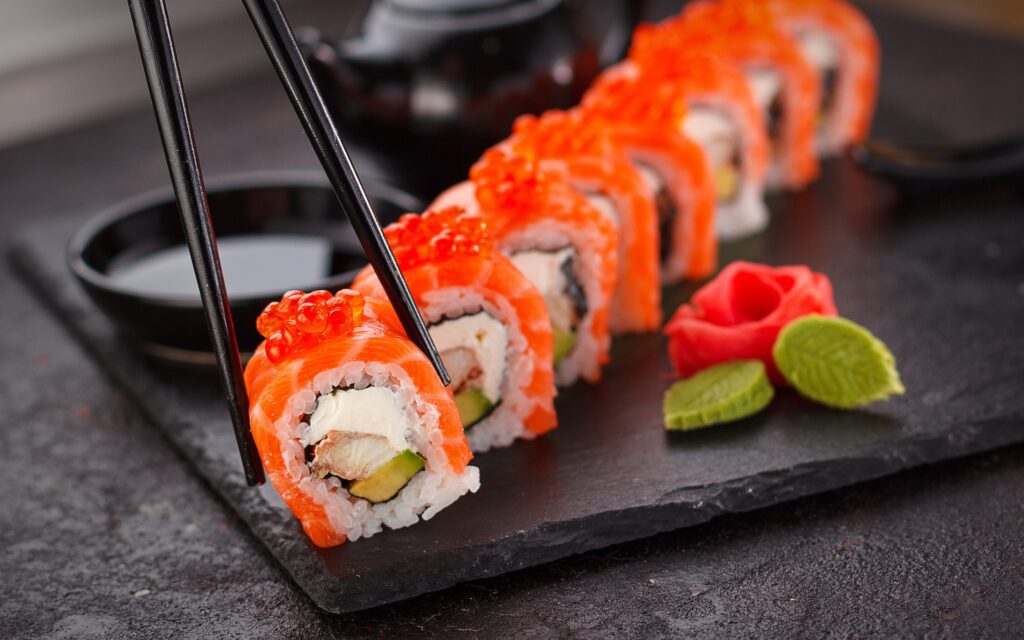When you order fresh Japanese seafood you typically have two choices: sashimi or sushi. While these terms are frequently used interchangeably, and though many people describe sashimi as a type of sushi, they are entirely different.
Related: Price Mark now selling sushi!
The first difference is that sashimi is thinly sliced raw meat; it is generally fish that is served without rice and is occasionally dipped in sauces, such as soy sauce with wasabi paste, and is sometimes served with sushi. Each piece is typically about one inch wide by one and a half inches long and one-fifth of an inch thick.
Sashimi is customarily some variety of salmon or tuna. Other favored types of sashimi are mackerel, clams, yellowtail, shrimp, scallops, and octopus.
Translated, sashimi literally means “pierced body.” The word is thought to have been derived from the fact that, traditionally, sashimi would have the fishtails or fins stuck to the meat itself, so you could identify which fish the meat came from. Another theory of the etymology of the word is the fact that as soon as the fish used for sashimi are caught, the brains are pierced to kill the fish without mutilating the meat. This also minimizes lactic acid in the meat by killing the fish instantly, which allows a longer storage period (as many as 10 days) without degrading the quality. Once the brain is pierced, the fish is immediately placed on ice.
Although numerous consumers take for granted that sushi is also raw fish, it is actually vinegar rice that is mixed with various other ingredients, which can be prepared with either cooked or raw fish.
It is often served with various types of seafood, either cooked or raw, and perhaps even a mix of the two; but that tradition simply comes from the primary food staples of the locations where sushi originated. Sushi can be served with just about any toppings or none at all.
While raw fish may be a traditional staple in the majority of Asian sushi dishes, it is not a prerequisite. Sushi translates into “it is sour,” and comes from an ancient grammatical form that is no longer used in other contexts. The “sour” descriptor comes from the ancient way of preparing sushi by fermentation of meat, typically seafood, packed in rice with salt used as a preservative. The vinegar produced from the fermenting rice breaks down the fish meat into amino acids. This, in turn, results in a strong umami flavor (pleasant savory taste) which is one of the five basic tastes the human tongue can detect. Once the meat was properly fermented, thereby preserved, the rice would then be discarded and only the meat itself would be consumed. Essentially, it was a way to preserve meat before refrigeration.
Today, sushi is not usually prepared in this fashion and the rice is now the main part of the meal. Somewhere during the Muromachi period (1336-1573 AD), vinegar was added, which assisted in preserving the food and in improving the flavor. Eventually, this led to the fermentation process being shortened and was subsequently abandoned in favor of eating it immediately with the rice.
It is quite possible sushi dishes that are served with raw seafood have given credence to the misconception that sushi is any dish served with raw fish. In point of fact, sushi is more commonly served in the western world with fully cooked seafood, including cooked imitation crab, which is known as a California roll; smoked salmon, also called a Seattle roll; grilled squid or octopus; fully cooked shrimp; and fully cooked clam. It is also often served with fried and an assortment of battered seafood. There are also assorted vegetarian sushi dishes, including the very popular maki (cucumber rolls).











